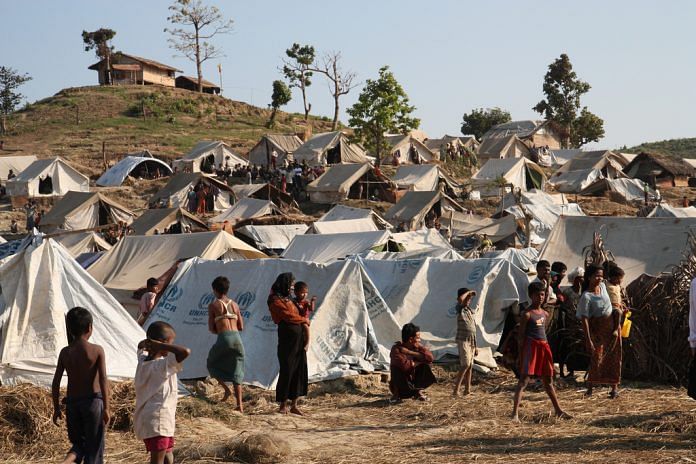Over the years, the Indian government has provided assistance to the likes of Bangladeshis and Afghans fleeing war and persecution, but has created disincentives for them to stay on in India permanently.
The Rohingya crisis in Myanmar has attracted global attention, concern, and condemnation over the past several weeks. India, while being both critical and supportive of the government of Myanmar, has been quick to respond with assistance to displaced Rohingya in Bangladesh.
But the crisis has also raised questions about India’s approach to refugees, specifically the 40,000 Rohingya that have entered the country in recent years. Minister of State for Home Affairs Kiren Rijiju has called them “illegal immigrants” who “stand to be deported,” but he subsequently clarified that there was not yet a plan for their removal. Such attempts might be complicated by a Supreme Court ruling against the deportation of asylum-seekers on the basis of the right to life and personal liberty. Moreover, because many Rohingya are effectively stateless, and not recognized as citizens by Myanmar, their forced repatriation could become problematic.
Although some 200,000 refugees reside in India, the central government lacks a national legal or policy regime concerning refugees. India is also not a signatory to either the 1951 United Nations Refugee Convention or the 1967 UN Protocol on Refugees. In the absence of international obligations or a national policy, the law that applies to asylum-seekers is the Foreigner’s Act of 1946, which gives the government the power to restrict the movement of non-Indian citizens not just into India but also within the country. The Foreigner’s Act – which defines a foreigner broadly as any person “who is not a citizen of India” – is vague about the differences between temporary residents, tourists, travelers, economic migrants, and refugees.
At present, the Indian government only recognizes about 110,000 Tibetans and 102,000 Sri Lankans as refugees. This may appear arbitrary, but is the product of political considerations. Tibetans who accompanied the Dalai Lama to India in 1959 were allowed to remain as refugees on the grounds that they were fleeing persecution by Chinese forces. They have been provided assistance and protection by the Indian government, and have freedom of movement and access to residence and work permits.
Sri Lankans began migrating to India in 1983 after the outbreak of a civil war between the Sri Lankan government and Tamil separatists. Over 67,000 Sri Lankan refugees remain in Indian camps, and a further 35,000 reside elsewhere in India, although some are in the process of returning. While provided with shelter, food, and allowances in designated camps and access to the informal labor market, their freedom of movement and employment opportunities are limited. Since 2012, India has also granted stay visas or long term visas to both Tibetan and Sri Lankan refugees. These have proved more popular with Tibetans, while Sri Lankans have been more liable to opt for voluntary repatriation.
By contrast, groups from Bangladesh and Pakistan have generally been considered economic migrants by the Indian government. For example, the Indian government never formally regarded those fleeing Bangladesh (then East Pakistan) in 1971 as refugees, despite providing them with considerable aid and assistance. This may have helped ensure their return following the conclusion of the India-Pakistan War in late 1971 that resulted in Bangladesh’s independence.
India’s ambiguity concerning its refugee policy does confer certain advantages. Specifically, it grants discretionary powers to the government to designate refugees and offer them asylum and other benefits. Creating a national policy or joining an international convention would hold India to certain standards and possibly limit options. India’s ambiguity has also led to its developing a unique relationship with the UN High Commissioner for Refugees (UNHCR). India allows the UNHCR to recognize, register, and protect certain groups of people as refugees after evaluating their claims on a case-by-case basis. So, for example, the UNHCR has registered refugees from Myanmar, Afghanistan and Somalia who continue to be treated as “foreign nationals” by the Indian government. More recently, the UNHCR has had to deal with Iraqi and Palestinian applicants seeking to reside in India temporarily, until they can be resettled in third countries such as the United States, United Kingdom, Germany, and Australia.
An Indian crackdown on illegal immigrants – including Rohingya – is consistent with its traditional hesitation about automatically designating asylum seekers as refugees. Over the years, the Indian government has provided assistance to the likes of Bangladeshis and Afghans fleeing war and persecution, but has created disincentives for them to stay on in India permanently. In the absence of a standard refugee policy, we can expect this approach to continue.




There may be noticeably a bundle to find out about this. I assume you made sure nice factors in features also.